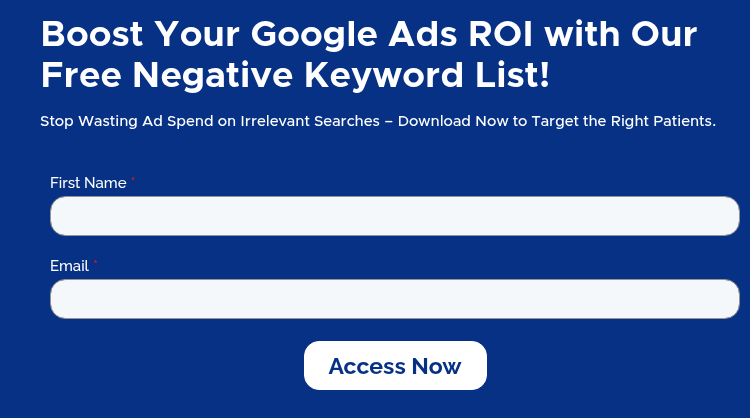*Originally published July 23rd, 2019, updated May 28, 2025.
If you’re reading this post, I think you’ll agree with me when I say:
Google Ads is an excellent way for dentists to increase their new patient count.
But are you confident you’re getting the most out of your ad spend? Are you wondering if your campaigns could deliver a higher return on investment (ROI)?
Google Ads can deliver exceptional ROAS (return on ad spend), but only if you do it right. While organic search engine optimization remains important, it can only take you so far. To grow your practice, you can’t neglect PPC for dentists; it’s one of the most effective dental marketing strategies available.
Google Ads remains a cornerstone of dental marketing ROI. It drives 50% more conversions than organic search, and users are four times more likely to click your ad on Google than on Bing or YouTube.
One study found that when people are searching for a product or service, Google Ads grab nearly two-thirds of all clicks on Google’s search engine results. That’s impressive, but there’s more to Google Ads than just increasing your clicks.
Today, we’ll discuss exactly how to increase the performance of Google Ads campaigns for your dental practice, covering everything from keyword selection, ad copy, and conversion-rate optimization.
*Note- We will be focusing on Google Ads in this blog post. That said, if you use Bing Ads, the same principles will apply in almost all scenarios.
Listen to this blog post:
Understanding Your Google Ads ROI as a Dental Practice
When we talk about Google Ads ROI (or ROAS, the terms will be used interchangeably), we mean the return on investment generated specifically from paid advertising campaigns on Google Ads for your dental practice. It shows how much revenue you earn for every dollar spent on ads.
The formula is simple:
ROI = (Revenue from Google Ads – Cost of Google Ads) ÷ Cost of Google Ads
For example, if you invest $2,000 in Google Ads and that generates $8,000 in new patient bookings, your ROI is (8,000 – 2,000) ÷ 2,000 = 3 — or 300%.
Keeping this formula top of mind ensures every optimization you make is tied directly to real financial results from your campaigns.
Even small improvements in your Google Ads performance can lead to significant gains. Imagine you spend $3,000 monthly on Google Ads, earn about $150 per new patient on their first visit, and convert 5% of landing page visitors, which results in about 7.5 new patients and $1,125 in revenue.
What if you could increase your conversion rate by just 2% to 7%? You’d gain 10.5 new patients, or $1,575 in revenue — an extra $450 per month without spending more on ads.

How to Increase the Effectiveness of Your Google Ads Campaigns
Now that you know why Google Ads are ideal for dental practices, let’s discuss how to maximize the return on ad spend. These strategies will help you minimize your spend and increase the number of clicks and conversions your ad campaign generates.
Here we go, let’s discuss seven ways to increase the return on ad spend for your dental practice.

1. Understand Your Ideal Patients
To get the best return on your investment from Google Ads, you have to understand your ideal patients. Understand what makes them tick. Understand where your best patients come from (area of town, zip code, etc), what they buy, how they pay, treatments they get, etc. Understand them in and out.
Create Patient Personas/Avatars/ICP: Develop detailed patient personas that capture age, gender, income, lifestyle choices, and treatment motivations.
Analyze Patient Data: Examine existing patient data to identify trends. What treatments are popular? Why do patients choose your practice? This insight shapes targeted marketing messages.
Engage through Surveys: Use surveys to gather current patient feedback on their experiences and expectations, showing that the practice values their opinions.
Tailored Content: Create ad copy, offers, and landing page copy that addresses your best patients' specific needs and concerns. If they are more affluent, then it may be better to lead with the benefits as opposed to a new patient special.
If you put yourself in the mind of your ideal patients and take the time to understand what makes them tick, you’ll be able to create Google Ads campaigns that resonate with your audience, leading to more clicks, more conversions, and ultimately more new patients.
We wrote a blog post about communicating the value you provide to patients, which you’ll want to read, and this post about developing a unique selling proposition as a dentist.
2. Target the Right Keywords
Once you understand your ideal patients better, you can do some keyword research. Google Ads can help you with this, or you can use a number of different keyword tools, or even an AI tool. Just be sure to check the keywords; don’t assume that the keyword tool or AI tool will get the information right.
Here are some tips to help you choose the right keywords for your Google Ads campaign.
- Target localized, long-tail keywords. These have less competition, they help you target your audience, and they tend to convert better than generalized keywords.
- Vary your keyword groups for different ads. For example, you might have one ad targeting keywords for dental hygiene, and another targeting cosmetic dentistry keywords.
- Choose negative keywords. This helps to eliminate irrelevant search terms and get more targeted traffic.
When you use these tips to create ads with highly targeted keyword groups, your ads will generate more clicks and get higher relevancy scores from Google (or Bing, or whatever search engine you’re using), making them appear higher on the SERP (search engine results page). This is important because it ultimately results in more clicks and more incoming leads that you can convert to new patients.
When choosing keywords, be sure to consider your strengths and weaknesses as a dentist and dental practice.
-
Consider the services that are more profitable and the ones that you enjoy more.
-
Consider what services generate additional new patients (families) vs single patients.
- Consider bidding more on terms that generate longer-staying customers.
The last thing you want is to be spending money on keywords and ultimately getting new patient leads for services that you hate to perform.
3. Use Negative Keywords
Negative keywords?
Yes. These are the keywords you DON’T want to show up for.
Incorporating negative keywords into campaigns can significantly improve the effectiveness by ensuring irrelevant search terms do not trigger your ads. By filtering out keywords that do not pertain to dental services, you can target potential patients who are more likely to convert, leading to improved click-through rates (CTR) and overall conversion rates. This strategic approach ultimately boosts your return on investment.
Consider using negative keywords such as:
- Free
- Cheap
- DIY
- Jobs
By pinpointing and including these keywords in your campaign settings, you can prevent your ads from appearing in searches that don't align with your offerings. This not only sharpens the focus of your advertising efforts but also helps eliminate unnecessary expenses on ads that won't lead to new patient conversions.

4. Optimize Your Ads for Phone Calls
As of 2024, mobile devices account for over half of all organic searches. That trend is likely to increase.
What that means for Google Ads is that enabling phone calls directly through your ads will continue to be essential for campaign success. For a dental office, a phone call means the patient you’ve connected with via your Google Ads is ready to book an appointment.
You can add your phone number to your Google Ad without it contributing to your character limit by using Google’s phone number extension. This extension allows mobile users to click on your number to call you. (You should also look into the other ad extensions offered by Google, including the location extension and seller rating extension.)
Finally, to maximize your Google Ads call-generating potential, set up your phone number-optimized ads to display only during business hours when someone is available to pick up the phone.
The takeaway: Include your phone number, preferably a call tracking number, in your ad to uncover additional data you may need to determine your ROI.
To learn more about how call tracking works, read our blog post:
A Comparison of 15 Call Tracking Solutions for Dentists
5. Create Conversion-Optimized Landing Pages for Dental Procedures
Sending your Google Ads traffic to your homepage or another unrelated page of your website is a conversion killer! It’s one of the most common mistakes we see.
If you want to get conversions, not just clicks, you need to link your ad to a targeted landing page.
Here are some elements to put on your optimized landing page:
- Content directly related to your Google Ads offer and keywords
- A bold, eye-catching headline
- Your logo
- A symbol of trust (e.g., BBB, awards)
- A compelling CTA with a short, simple opt-in form
- A video to build trust and boost engagement
Dental-Specific Landing Page Enhancements
- Clearly list accepted insurance providers
- Feature new patient specials or discounts
- Highlight emergency appointment availability
- Include patient testimonials with names and photos
You might also consider adding a video to your landing page, as video has been proven to increase conversion rates.
An optimized landing page for a dentist contains these elements combined with a clean, simple design. For mobile users, ensure the page loads fast, forms are easy to tap, and key info (including phone number and address) is front and center.
You can see the landing page below encompasses many of those qualities.
 6. Use Call and Lead Tracking
6. Use Call and Lead Tracking
One of the most overlooked strategies in dental Google Ads campaigns is tracking what happens after the click. Without proper tracking in place, you could be generating calls and leads without knowing which ads or keywords are responsible, making it nearly impossible to optimize performance or prove ROI.
Dental call & lead tracking closes that gap. By using a call tracking solution with dynamic number insertion, you can assign unique phone numbers to different campaigns, ad groups, sources, landing pages, etc. This allows you to attribute exactly which source generated the call or appointment request. It’s also helpful to record calls (with proper consent) to assess lead quality and improve your front desk’s phone performance.
Beyond phone calls, lead tracking through your forms is just as critical. Tools like Google Tag Manager and CRM integrations can help you track form submissions, live chat inquiries, and other digital conversions directly back to your Google Ads.
With detailed attribution data, you can double down on high-performing campaigns and refine or eliminate the underperformers. That insight is invaluable when every dollar spent on ads needs to translate into measurable growth for your practice.
The video below explains how our lead tracking dashboard works. This dashboard gives us a deeper insight into the performance of our client's ad campaigns, ultimately allowing us to get them better results. We also give our clients access to the lead dashboard so they can have this same important data.
7. Track and Test Your Campaign
We’ve already discussed how easy it is to track your results with Google Ads. Even so, Google Ads takes a bit of trial and error to perfect. Tracking your campaign metrics allows you to determine what works and what doesn’t.
You will get a clearer picture of your ads' ROI by monitoring your click-through rates, conversions, and other campaign metrics. This will allow you to identify what you need to tweak to improve it.
For example, you might want to experiment with different keywords, background colors, and CTAs. Once you develop some variables, you can use split testing to see which options give you the best possible ROI for your Google Ad campaigns.
Be careful on this, though. There are opinions on both sides of the aisle regarding testing your campaigns. Some say that testing isn’t necessary because, quite frankly, you won’t get enough data to come to a proper conclusion. Others insist it’s necessary.
I’m in the middle; we are a bit more conservative typically. We have frameworks in place that we’ve refined over the past 10+ years, so we know what works. For example, we aren’t big believers in changing button color to see if yellow converts better than blue. If you are managing your ads on your own, we’d suggest keeping testing to a minimum and not making too many changes. Making too many changes makes it more difficult for Google to understand your campaigns and deliver you optimal leads.
When you test, test only one element at a time. Test headlines, and then, when you’re happy, try testing out new patient offers or ad text.
Google Ads can be an affordable and effective way to jump to the top of the search engine results page and get more traffic to your website. When managed well, they add far more value than they cost. The key is understanding how to use Google Ads properly and optimizing all your ads, regardless of which search engine you use, to maximize their effectiveness and increase your return on ad spend.
Note: If your campaigns involve call tracking or form submissions, be sure your tracking tools are HIPAA-compliant to protect patient data and ensure legal safety.
Now, let’s see it in action. We’ll show you the results of one of our clients that is running Google Ads.
How Google Ads Drove Practice Growth: A Case Study for Dentists
A dentist came to us who bought into an existing practice. This office had worked with a large national marketing agency, but wasn’t pleased with the results. They needed a marketing partner, not just a vendor, to support their expansion and rebrand. Which included a new company name, logo, colors, style guide, domain recommendations, website, etc.
The Challenge
Because they were now running with two dentists, they needed to get more new patients sooner rather than later (as SEO can take some time, PPC was their best option). They also had no tracking in place, so it was impossible to know their source for those few leads they were getting from the internet.
Our Solution
We developed a comprehensive Google Ads strategy that included:
- Mobile-optimized, conversion-focused landing pages
- Segmented Google Ads campaigns (emergency, cosmetic, new patients)
- A custom lead tracking system to monitor performance across all ad types
- Ongoing testing and campaign refinement
- Continued review, competitive research, and market research to identify areas of opportunity.
- Approval for Google Local Services Ads in their market
The Results
- Over a dozen page-one rankings within 3 months
- Monthly leads grew from essentially 0 to ~450 to 1,007 by January 2024 (PPC and SEO leads)
- Practice hired 4 additional dentists
- Moved into a new, state-of-the-art building


Strategically managed Google Ads accounts with the help of a professional, paired with strong landing pages and lead tracking, helped this dental practice dramatically scale its patient acquisition and revenue.
Frequently Asked Questions About Improving Your ROI from Google Ads
You likely have some questions about Google Ads. We’ve compiled some of the most common questions dental practices ask when navigating Google Ads and tracking return on investment. These answers will help you make smarter decisions and maximize your marketing spend.
What is a good ROI for Google Ads campaigns?
A strong ROI typically ranges from 3:1 to 10:1, depending on your service mix and patient lifetime value. The key is consistent tracking and optimization.
How much should a dental practice spend on Google Ads?
Budgets vary by location and goals, but many dental practices start with $1,500–$5,000/month. Higher competition areas or specialty services may require more.
How long before I see results from my Google Ads campaign?
You may see initial leads within days, but optimal performance usually takes 60–90 days as campaigns are tested and refined. With a decent budget, leads often come within a few weeks.
Should I run different campaigns for different dental services?
Yes. Segmenting by service, such as emergency, cosmetic, or pediatric dentistry, improves ad relevance, click-through rates, and conversions.
How do I know if my landing page is converting?
Track how many visitors are going to the landing page, and how many leads you get from the landing page (calls and form submissions).
Can I run Google Ads for multiple practice locations?
Absolutely. Create separate campaigns with geo-targeted keywords and dedicated landing pages for each location to maximize local relevance.
How much do you charge for PPC management?
We have competitive rates. A budget up to $1500 is $349 per month to manage, plus a setup fee. $1501–$2500 is $549 per month, plus a setup fee. Inquire for more pricing tiers.
What’s included in your PPC management?
Everything needed to succeed: account setup, keyword research, landing page design, full campaign buildout, ongoing management and optimization, and lead tracking.
Final Thoughts on Boosting Your Dental Google Ads ROI
Maximizing ROI with Google Ads goes beyond setting a monthly budget. It requires a smart, data-driven approach — from selecting high-intent keywords to building conversion-focused landing pages and ensuring HIPAA compliance.
One key area many practices overlook is how they allocate their ad spend. A dynamic budget strategy helps you reduce waste and scale what’s working by focusing on:
-
High-value services like implants and cosmetic treatments
-
Seasonal trends (e.g., back-to-school or year-end insurance rush)
-
Top-performing campaigns with lower cost per lead
- Practice availability, so you only promote services you can fulfill
When tied to call tracking and conversion data, this approach puts you in full control of performance and patient growth.
Need expert help to get better results from your campaigns? Let’s talk. At Titan Web Agency, we help dental practices attract more patients with strategic, ROI-focused Google Ads management.
Looking to get more out of your Google Ads campaigns?
Schedule a FREE consultation!
Let's help your dental practice attract more patients with less wasted spend — no pressure, just results...
Tyson Downs is the founder of Titan Web Agency, a company specializing in marketing for dental professionals. With an impressive track record of working with over 100 dental practices, Tyson has a deep understanding of the unique marketing needs within the dental industry.











.png)
.png)

.jpg)
